You’ve heard the saying, your mileage may vary? The same applies to oil and filter changes, too. The intervals (time and mileage accrued) are general recommendations that may not apply in your specific circumstances.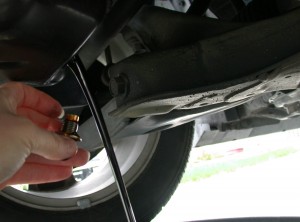
Variables that affect change intervals include: How old the car is; how often the car is driven; how the car is driven.
Let’s look at each.
* How old is your car?
Older cars usually need more frequent oil/filter changes. In part, because their design requires it – but also because of their age. Older/high-mileage car engines are more likely to have varnish and sludge build-up than newer/lower mileage engines. More frequent oil changes will help clear out the gunk – and help keep the engine clean. If your car is really old – and has a carburetor – you may need to abide by the old three months/3,000 mile standard.
Carburetors tend to leak/seep raw gas (which is a solvent) into the engine, which dilutes the oil. Carbureted engines also tend to not have ideal air-fuel mixtures; often, they run a little rich or a little lean. A little rich (more gas than ideal) and carbon and such tends to accrue, which contaminates the oil. A little lean and the engine may run hot, which makes life harder on the oil (and additive package) which shortens the oil’s useful service life.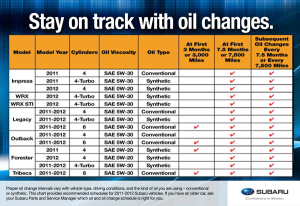
The advent of computer controlled engine management and fuel injection ameliorated both these issues – and that’s one of the big reasons why advertised oil/filter change intervals have lengthened over the past couple of decades.
* How often is the car driven?
It’s kind of counterintuitive, but – generally – the less you use your car, the more often you probably ought to change the oil (and filter). There are two reasons why. First, a car that sits a lot is more vulnerable to the accumulation (inside the engine) of moisture resulting from condensation. Oil and water don’t mix well, as you know – and water contamination can lead to rust inside the engine, which is something you don’t want to happen. Running the engine heats it up and burns off moisture but if the engine is run only briefly and occasionally, it might not get hot enough to burn off the moisture and as it cools down again, more moisture accumulates. You may see where this is headed.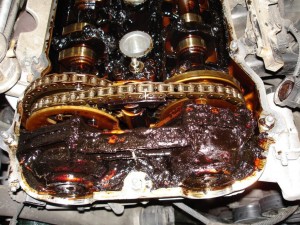
Older cars (especially those made before the adoption of fuel injection and computer engine controls, so circa mid-1980s and prior) are especially vulnerable and should have their oil/filter changed at least as often as the original factory recommendation and probably more often, if they’re left to sit for weeks at a time (by now, most of these ’80s-era and older cars are recreational/hobby cars and not used regularly almost by default).
There are specially formulated oils (Amsoil, which I personally use and highly recommend; see here for more) designed specifically for older car engines, both their type (the oil contains the special anti-friction additives needed by these older engines) as well as the occasional use they tend to see.
* How is the car driven?
A race car’s engine gets maybe a few hundred miles of life out of fresh oil (and often, the engine itself only lasts a few hundred miles – or less – before it’s torn down and rebuilt). Hard use = shorter life. But hard use – in a street car – can mean things you might not expect.
It can mean stop-and-go driving, periods of prolonged idling… the kind of driving most of us who commute do pretty much every day. It doesn’t feel like hard use, but it is – and (check your vehicle’s owner’s manual) may mean shorter-than-advertised change intervals.
The tricky thing is that the manufacturers like to tout the longer/best-case intervals as a selling point. It’s not unlike the gas mileage figures they tout – which are also best-case figures.
The fact is that your mileage may vary – in both cases.
Incidentals:
* Many late-model cars have oil/filter change reminders and/or oil-life monitors. Some are “smart” … and some not-so-much.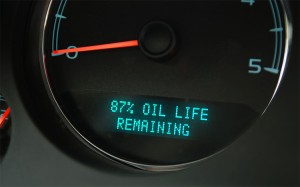
It’s important to know which your car has before you rely on it as the basis for deciding when to change the oil. The smart systems have the ability to sample the oil and monitor its condition. It’s kind of like having your own lab analysis to go. These systems will let you know when it’s time to change the oil – whether sooner or later – depending on the oil’s actual condition, based on your actual driving habits.
The dumb systems are simply mileage meters that trigger a “change oil” light after say 5,000 miles of driving (or whatever it was set for). In fact, the oil may have been tired at 3,000 miles – or good to go for another 5,000.
So, how to know which system you have? The information should be in your owner’s manual. If not, ask at the dealer – but ask them to show you something in writing, from the manufacturer of your vehicle. Don’t decide based solely on what the service advisor tells you. He may be a salesman who works on commission.
* Using the “right” oil (and filter).
New/recent model cars can be very finicky about the type of oil they need – and the car manufacturers can be very finicky about warranty coverage if you use something other than the specified weight (e.g., 5W30 rather than 0W20) or oil that doesn’t meet the minimum SAE requirements for the vehicle (see here for more info).
In older cars, you could usually safely use a heavier weight (such as 20W50) in lieu of (or mixed with) a lighter weight (such as 10W40) without worrying about potential mechanical or warranty issues. But they didn’t have variable cam/valve timing systems (which use engine oil, typically) or have the extremely tight internal tolerances modern car engines typically have. In a pinch, it’s probably ok to top off with say a quart of 5W30 if that’s all that’s available. But if your engine wants say 0W20 oil, that’s what you should use. If you’re forced to use something else, it’s smart policy to change the oil as soon as possible – and refill it with the manufacturer-specified weight.
If you do your own oil and filter changes (or even if you have them done by an independent repair shop) be sure to keep receipts and records that state when the work was done (date and mileage) as well as the type/weight of oil and the type/brand of filter used. Be sure this is clearly spelled out on your receipt – not just “oil change” or “five quarts” and “filter.”
If you ever have to make a warranty claim for something that’s oil-related, this paper trail may be the difference between the manufacturer honoring the warranty… or not.
The manufacturer isn’t being shady. It’s reasonable for them to deny a claim if the vehicle owner filled the engine with oil that didn’t meet their specifications or used an el-cheapo oil filter that failed and then so did the engine. Keeping records and receipts keeps everyone honest. You can prove you maintained the car properly – and they can’t shirk paying for a problem caused by poor design or shoddy assembly by blaming it on your not maintaining the car properly.
EPautos.com depends on you to keep the wheels turning! The control freaks (Clovers) hate us. Goo-guhl blackballed us.
Will you help us?
Our donate button is here.
If you prefer not to use PayPal, our mailing address is:
EPautos
721 Hummingbird Lane SE
Copper Hill, VA 24079
PS: EPautos stickers are free to those who sign up for a $5 or more monthly recurring donation to support EPautos, or for a one-time donation of $10 or more. (Please be sure to tell us you want a sticker – and also, provide an address, so we know where to mail the thing!)


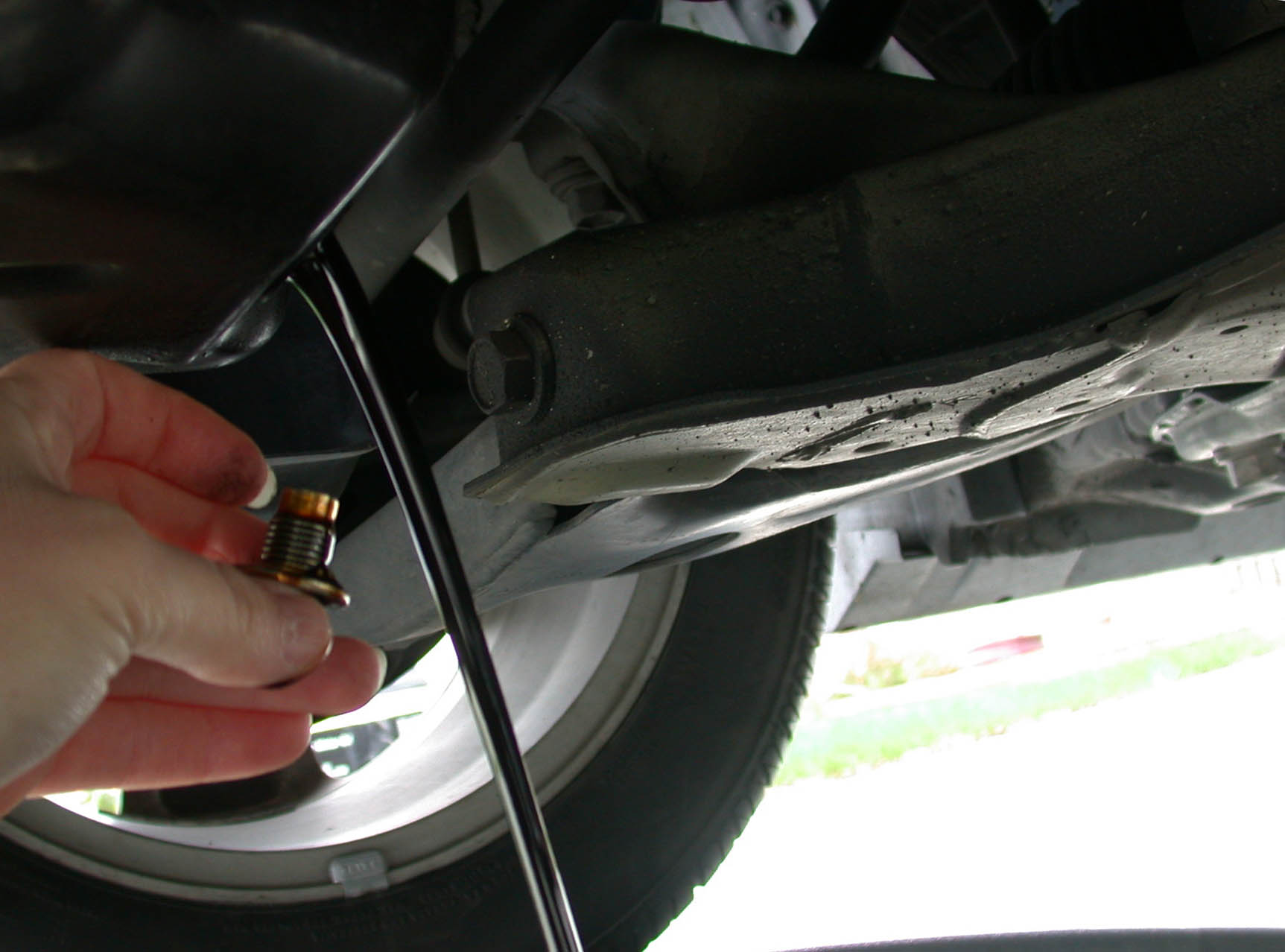

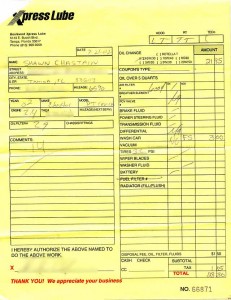







I’ve got the record of every oil change (and other maintenance) done on my F150 since it left the showroom floor in March of 1996.
For the first 100K miles it was always Motorcraft 10W-30 on a 3,500 mile interval. As it has gotten up there in age (and the fact that I rarely take the old 6 over 2500 RPM), I’ve switched over to 10W-40 Motorcraft with the same old FL-1A filters that it has always had.
This truck once did a fine job of illustrating the necessity of spending the small amount of extra coin on quality filters – due to being away from home and dealing with other issues, the routine oil change was left in the “capable” hands of a certain chain of stores rather than myself or the non-existent local Ford dealer. After stopping to get something to eat on the way home, I noticed an oil spot under the truck. As this engine has NEVER leaked a drop, I flung the hood open and found that the “Pennzoil” branded oil filter had swelled and was starting to split at the “welded” seam. This turned into my first (and only) oil change performed in a Jack in the Box parking lot, and the absolute LAST time I will ever trust anyone other than myself or a dealer to perform maintenance on my rides.
Something else I have learned with especially the older rides is that it pays to have an oil analysis done every once in a while. For the few bucks that it costs, it can catch a problem BEFORE it really manifests. I caught a degrading main bearing on my old (thankfully rarely driven) Falcon’s 289 before it managed to do any damage other than to the insert itself.
I once used Fl-1A filters on my GM stuff as well as Motorcraft plugs. Of course now there are “forever” plugs with multi-electrodes so I abandoned single electrode plugs. Once I changed to Amsoil I changed to their filters also since they have the specs on their website of how much of each size grit virtually every brand of filter catches. I doubt I’ll ever use a different brand filter and probably not lubricant. The Amsoil dual element air filters seem to last forever and there is zero stuff on the downside as opposed to other air filters. Many make quality air filters but a cleanable one is much cheaper, esp. with a turbo-diesel and in west Tx. where dirt is ever present.
Pennzoil is the only oil I ever knew to ruin an engine immediately after an oil change. A friend used Pennzoil in his farming operation. He changed oil one day in a 4430 John Deere and a ’78 Chevy pickup, both of which proceeded to give up immediately. He had the oil tested and long story short, Pennzoil had to buy him two new engines. He changed to Mobil at that point and had no further problems.
I usually run with what the manufacturer recommends, however, some manufacturers are intentionally recommending thin motor oil in order to meet gas mileage requirements. There are times, not too often, when it can lead to catastrophic engine failure. I encountered just that when I decided to purchase a 2007 Ford Mustang GT. This car looked to be lightly driven and adequately maintained by its prior owner. I took it to have a prepurchase inspection before I bought it, but it failed to identify what was to come.
One day, I was driving down the road and the engine all of a sudden started to jump time and began knocking. I pulled it to the side of the road, but the damage was already done. A rocker arm had broken and three valve lifters collapsed on each side of the engine. After almost a year of hunting down cylinder heads, timing chains, cam phasers, and other related parts., the car was put back and I ran the car. I replaced the oil pump as well. It was running very well when I got it back. One day, I decided to change the oil to an Amsoil 5/30 synthetic. About 5 miles after driving the car, the car began to sound like it was jumping time again. I jammed on the gas and the phasers returned to normal operation.
I talked to the mechanic and he stated that the cam phasers run on oil pressure. I went to change the oil again to a 10W40 and it hasn’t done it again.
Of course, I later find out Ford has had a load of problems with the 3V 4.6 and 5.4 modular engines with the cam phasers, yet has never fully addressed the problem.
It was my fault for not properly researching this, but I think I will be okay with using this oil and chaining it fairly often to make sure that the viscosity remains closer to 40 than it does to 30 during heavy duty operation.
swamprat, manufacturers recommend lower viscosity oils because the engines have much closer tolerances these days and a heavier oil will starve the components until the operating temperature is reached. It’s the raison d’etre of multi-weight oils.
The company bought a used 2006 Chevy 1500 with a 5.3L, about 150K on it. It was barely audible running, ran like a scalded dog and got great fuel mileage. Some guys in the shop think Rotella T 15W40 is the only oil there is. I warned them to not use it in that pickup. But the words of an old man can’t be heard. Now the poor engine sounds like it has 16 little hammers going bonkers in it since they used Rotella in it anyway. It really messed up the upper end and will be run till it ruins the whole engine. I cringe every time I have to use it. I think the book shows 5W30 for the temperature of this country, lower for colder climes. It’s not just for fuel mileage.
small passageways in the ford modular engines make heavier oils a concern. This is something that came up in debates on 5W/30 20 years ago.
On the phaser’s operation, I found this: https://www.youtube.com/watch?v=O7GcqtNTMqQ
Now I see why people said these things need the anti drainback valve in the oil filter. But I’ve also learned that VCT solenoids timing chain guides and tensioner seals can also cause phasers to fail to operate properly.
Anyway the heavier oil may just be band-aiding some other area where oil pressure isn’t correct.
My 98 intrigue recommends 10w30 for temperatures 32F (freezing) and higher. 10w30 is what is stamped on the oil cap. However, the manual also shows a chart that 5w30 can be used at any temperature below 60F.
This winter I decided to use 5w30 because there are quite a few days where temps drop below freezing here in nj.
Using conventional oil instead of synthetic solved the problem where my low oil light would come on.
I run Amsoil 10W30 “VRod” oil in the Trans-Am. It is lighter than what I used to use (10W40) but seems to make my car’s 455 happy, regardless of season. In winter, cold starts are easier and in summer I have notice slightly lower operating temp (big factor with that big 455, which generates a lot of heat). But the really intriguing thing about the Amsoil is that oil consumption has fallen to almost nil. When I was running Mobil 1, I used to lose a quart over about 3,000 miles. Now, the consumption is less than half that.
eric, only one vehicle I converted didn’t use less oil and actually used more oil with Amsoil. Of course I don’t think that would have continued had it been used more than once. This friend does some not too bright stuff with his vehicles. He took it to a service of some sort and had Mobil 1 substituted for Amsoil instead of calling me. They ripped off his brand new $80 dual element Amsoil air filter I installed and wouldn’t go back and confront them. Since everyone else had such good results with Amsoil I had changed over, I think he just needed a bad result to show me. I shook my head on the air cleaner.
When would your oil light come on? At what temp? At what rpm? The first number is derived from the pour point at 0 degrees C. W meaning “winter”. The upper number is based on the viscosity at 100 degrees C. I’ve never had a problem using 0W30 in the summer(GM 3.1) or 0W20 winter. I’m assuming your low light is pressure, or lack thereof. Seems strange in that operating temperature weight is the same for both oils. Of course the viscosity of a conventional oil is almost always higher at lower temps so it will maintain the viscosity(this case being 30)at the rated temp for the oil.
A synthetic oil has molecules that are of a very close size compared to conventional oil, the reason an oil with 30 for the higher number results in higher pressure at higher temps.
Of course the heavier oil needed in conventional oil will result in less oil flow at low temps too since it doesn’t flow as well. Synthetic oil is a win/win situation regardless. More engines every year require synthetic oil, something that will only continue to be the norm as operating temps are higher, tolerances are closer and compression ratios continue to climb.
Reddit’s /r/justrolledintotheshop subreddit has pictures all the time of sludged-up engines, where the owner has sometimes gone 50k miles or more between oil changes.
(and is shocked! SHOCKED I say! at the mere suggestion that they now have to pay several thousands of dollars for a new engine)
As cars have gotten better, regular maintenance is not something that is in the owner’s minds.
In my late teens I happened to be at the service station at the same time with my neighbor, a couple years older than me who had a year old Mustang, maybe two years old. I mentioned I had to changed oil and filter. He allowed he probably did too. I asked how many miles he had on the current. He replied he’d never changed it. I looked at the odometer, something like 46,000. I told him it would be a good idea.
Back then I sweated it when oil began to lose that bright look. Probably a good thing since I never had an engine that didn’t use oil. It wasn’t the engines that were at fault but my driving style.
I later learned to change more than oil and filter, topped off battery, checked coolant level and look, checked gearboxes, brakes, etc. I finally learned to keep a log book and write things down I observed along with mileage of changes of various things.
A friend used to change his Mobil 30 every 3,000 miles in his highly abused TA. He kept the drained oil and let the station owner have it who used it in his car. Just sayin.